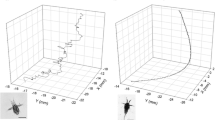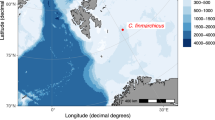Abstract
In this study we demonstrate the sensitivity of swimming behavior and predator-escape responses of nauplii of the estuarine copepod Eurytemora affinis to sublethal doses of Cu and Cd. Behavior was generally altered at metal doses below those affecting growth rates or survival of the copepods. Swimming velocities of Cu-dosed nauplii were different from controls at all concentrations of Cu tested (10–50 μg l-1 total Cu) after 24- to 48-h exposure, whereas development rate of nauplii was significantly reduced only after 96 h at 25 μg l-1. The 96 h LC50 for Cu was approximately 30 μg l-1 Cu. Naupliar swimming velocity was also affected by Cd. Swimming speeds were reduced after 24 h at 130 μg l-1, and development was slowed after 48 h at 116 μg Cd l-1. The 96-h LC50 was >120 μg l-1. Little is known of the adaptive role of specific motile behaviors in the success of larval copepods. We investigated the relationship of swimming speed to predator — prey interactions of the nauplii using both real and simulated predators. Nauplii exposed to Cu for 24 h were observed to be generally hyperactive, a condition which could increase their encounter frequency with predators. Reduced numbers of escape responses of nauplii to a simulated predator, another indication of increased vulnerability to predation, were observed only after 48-h exposure to Cu. Nevertheless, feeding rates of non-dosed larval striped bass on dosed nauplii (24 h at 25 μg Cu l-1) were significantly higher than on control nauplii. Feeding rates of larval mysid shrimp, however, were not higher on similarly dosed nauplii; 24 h exposure of nauplii to >30 μg Cu l-1 did result in increased predation by mysids.
Similar content being viewed by others

Literature cited
Allan, J. D. and R. E. Daniels: Life table evaluation of chronic exposure of Eurytemora affinis (Copepoda) to kepone. Mar. Biol. 66, 179–184 (1982)
Berdugo, V., R. P. Harris and S. C. O'Hara: The effect of petroleum hydrocarbons on reproduction of an estuarine planktonic copepod in laboratory cultures. Mar. Pollut. Bull. 8 (6), 138–143 (1977)
Davies, A. G.: Pollution studies with marine plankton. Part II. Heavy metals. Adv. mar. Biol. 15, 381–508 (1978)
Farr, J. A.: Impairment of antipredator behavior in Palaemonetes pugio by exposure to sublethal doses of parathion. Trans. Am. Fish. Soc. 106, 287–290 (1977)
Feigenbaum, D., and M. R. Reeve: Prey detection in the Chaetognatha: response to a vibrating probe and experimental determination of attack distance in large aquaria. Limnol. Oceanogr. 22, 1052–1058 (1977)
Gauld, D. T.: Swimming and feeding in crustacean larvae: the nauplius larva. Proc. Zool. Soc. London 132, 31–50 (1959)
Gentile, J. H., S. M. Gentile, N. Hairston, Jr. and B. K. Sullivan: The use of life-tables for evaluating the chronic toxicity of pollutants to Mysidopsis bahia. Hydrobiologia 93, 179–187 (1982)
Gerritsen, J.: Instar-specific swimming patterns and predation of planktonic copepods. Verh. internat. Verein. Limnol. 25, 2531–2536 (1978)
Gerritsen, J. and J. R. Strickler: Encounter probabilities and community structure in zooplankton: a mathematical model. J. Fish. Res. Bd Can. 34, 73–82 (1977)
Giguere, L. A. and L. M. Dill: The predatory response of Chaoborus larvae to acoustic stimuli, and the acoustic characteristics of their prey. Z. Tierpsychol. 50, 113–123 (1979)
Giguere, L. A., A. Delage, L. J. Dill and J. Gerritsen: Predicting encounter rates for zooplankton: a model assuming a cylindrical encounter field. Can. J. Fish. aquat. Sci. 39, 237–242 (1982)
Greaves, J. O. B. and R. S. Wilson: Development of an interactive system to study sub-lethal effects of pollutants on the behavior of organisms. US Environmental Protection Agency, EPA-600/3-80-010, 1980
Haertel, L., C. Osterberg, H. Curl, Jr. and P. Kilho Park: Nutrient and plankton ecology of the Columbia River Estuary. Ecology 50, 962–978 (1969)
Haury, L. R., D. E. Kenyon and J. R. Brooks: Experimental evaluation of the avoidance reaction of Calanus finmarchicus. J. Plankton Res. 2, 187–202 (1980)
Heinle, D. R. and D. A. Flemer: Carbon requirements of a population of the estuarine copepod Eurytemora affinis. Mar. Biol. 31, 235–247 (1975)
Hunter, J. R.: Swimming and feeding of larval anchovy Engraulis mordax. Fish. Bull. U.S. 70, 821–838 (1972)
Jeffries, H. P.: Salinity-space distribution of the estuarine genus Eurytemora. Int. Revue ges. Hydrobiol. 47, 291–300 (1962)
Katona, S. K.: Growth characteristics of the copepods Eurytemora affinis and E. herdmani in laboratory cultures. Helgoländer wiss. Meeresunters. 20, 373–384 (1970)
Lang, W. H., R. B. Forward, Jr., D. C. Miller and M. Marcy: Acute toxicity and sublethal behavioral effects of copper on barnacle nauplii (Balanus improvisus). Mar. Biol. 58, 139–145 (1980)
Lang, W. H., D. C. Miller, P. J. Ritacco and M. Marcy: The effects of copper and cadmium on the behavior and development of barnacle larvae. In: Biological monitoring of marine pollutants, pp 165–203. Ed. by F. J. Vernberg, A. Calabrese, F. Thurberg, W. B. Vernberg. New York: Academic Press 1981
Miller, D. C.: Some applications of locomotor response in pollution effects measurement. Rapp. P.-V. Reun. Cons. int. Explor. Mer 179, 154–161 (1980)
Mirkes, D. Z., W. B. Vernberg and P. J. DeCoursey: Effects of cadmium and mercury on the behavioral responses and development of Eurypanopeus depressus larvae. Mar. Biol. 147, 143–147 (1978)
Olla, B. L., W. H. Pearson and A. L. Studholme: Applicability of behavioral measures in environmental stress assessment. Rapp. P.-V. Reun. Cons. int. Explor. Mer 179, 162–173 (1980)
Paffenhöfer, G. A., J. R. Strickler and M. Alcaraz: Suspension-feeding by herbivorous calanoid copepods: a cinematographic study. Mar. Biol. 67, 193–199 (1982)
Pearcy, W. G.: Ecology of an estuarine population of winter flounder, Pseudopleuronectes americanus (Walbaum). IV. Food habits of larvae and juveniles. Bull. Bingham oceanogr. Coll. 18, 65–78 (1962)
Reeve, M. R., M. A. Walter, K. Darcy and T. Ikeda: Evaluation of potential indicators of sub-lethal toxic stress on marine zooplankton (feeding, fecundity, respiration, and excretion): controlled ecosystem pollution experiment. Bull. mar. Sci. 27, 105–113 (1977)
Sosnowski, S. L., D. J. Germond and J. H. Gentile: The effect of nutrition on the response of field populations of the calanoid copepod Acartia tonsa to copper. Water Res. 13, 449–452 (1979)
Steel, R. G. D. and J. H. Torrie: Principles and procedures of statistics. New York: McGraw-Hill Book Company, Inc. 1960
Strickler, J. R. and A. K. Bal: Setae of the first antennae of the copepod Cyclops scutifer (Sars): their structure and importance. Proc. nat. Acad. Sci. U.S.A. 70, 9, 2656–2659 (1973)
Sunda, W. G., D. W. Engel and R. Thuotte. Effect of chemical speciation on toxicity of cadmium to grass shrimp, Palaemonetes pugio: importance of free cadmium ion. Env. Sci. Techn. 12, 409–413 (1978)
Urech, J.: MELIMEX, an experimental heavy metal pollution study: effects of increased heavy metal on crustacea plankton. Schweiz. Z. Hydrol. 41, 247–260 (1977)
Wright, D. I. and W. J. O'Brien: Differential location of Chaoborus larvae and Daphnia by fish: the importance of motion and visible size. Am. Midl. Nat. 108, 68–73 (1982)
Author information
Authors and Affiliations
Additional information
Communicated by R. W. Doyle, Halifax
Contribution No. 272 of the US EPA Environmental Research Laboratory, Narragansett, Rhode Island 02882, USA
Rights and permissions
About this article
Cite this article
Sullivan, B.K., Buskey, E., Miller, D.C. et al. Effects of copper and cadmium on growth, swimming and predator avoidance in Eurytemora affinis (Copepoda). Mar. Biol. 77, 299–306 (1983). https://doi.org/10.1007/BF00395819
Accepted:
Issue Date:
DOI: https://doi.org/10.1007/BF00395819



